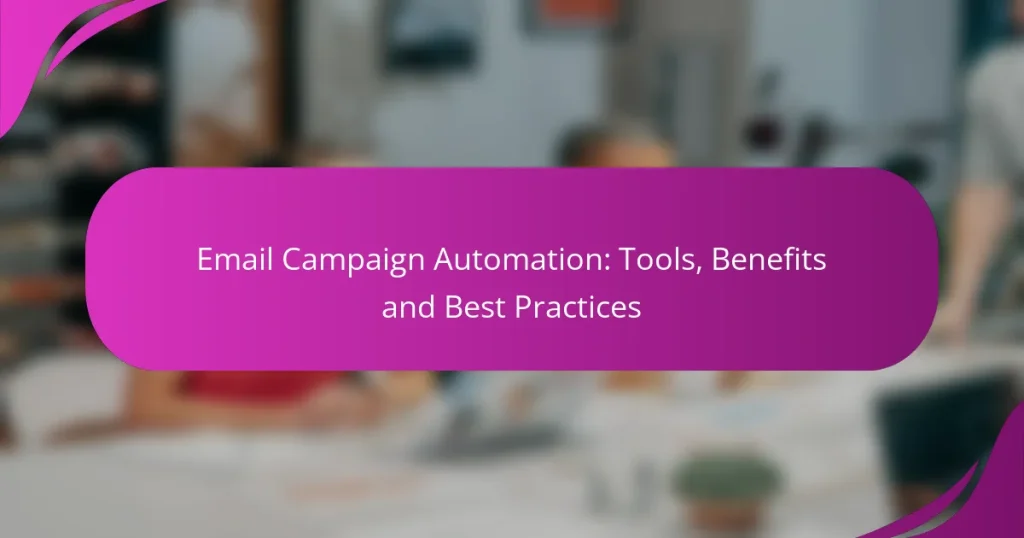Email campaign automation is a powerful strategy that enables businesses to enhance their marketing efforts through streamlined processes and personalized communication. By leveraging the right tools, companies can save time, improve engagement, and foster stronger customer relationships. Selecting an appropriate automation tool tailored to your business needs is crucial for maximizing these benefits.
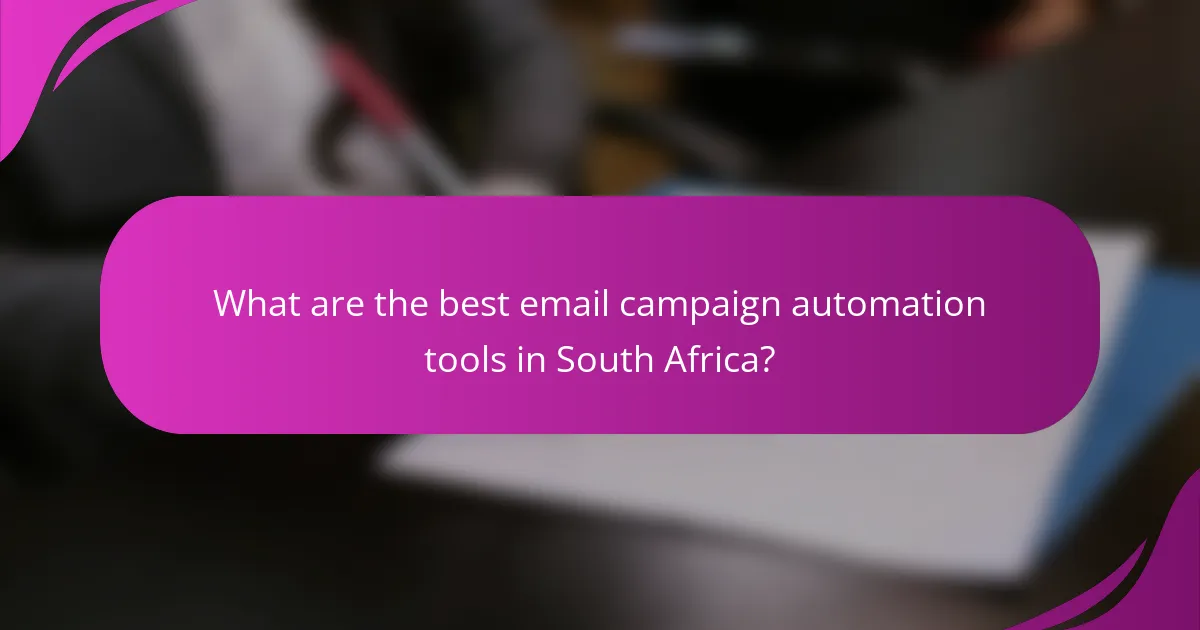
What are the best email campaign automation tools in South Africa?
In South Africa, several email campaign automation tools stand out for their features and usability. These tools help businesses streamline their email marketing efforts, improve engagement, and enhance customer relationships.
Mailchimp
Mailchimp is a popular choice for businesses of all sizes in South Africa due to its user-friendly interface and robust features. It offers a free tier that allows users to send up to 10,000 emails per month to 2,000 subscribers, making it accessible for small businesses.
Key features include customizable templates, A/B testing, and detailed analytics. Businesses should consider their growth potential, as Mailchimp’s pricing can increase significantly with larger subscriber lists.
ActiveCampaign
ActiveCampaign is known for its advanced automation capabilities and CRM integration. It allows users to create complex workflows that can trigger based on user behavior, making it ideal for businesses looking to personalize their marketing efforts.
Pricing starts at a moderate level, but the value comes from its powerful segmentation and analytics tools. Companies should evaluate their need for advanced features versus budget constraints when considering ActiveCampaign.
GetResponse
GetResponse offers a comprehensive suite of email marketing tools, including landing page creation and webinar hosting. This makes it a versatile option for businesses looking to integrate multiple marketing strategies.
With plans starting at a competitive rate, GetResponse provides features like automation workflows and detailed reporting. Businesses should assess whether they need these additional functionalities to justify the investment.
HubSpot
HubSpot is a leading platform that combines email marketing with a full suite of inbound marketing tools. Its email automation features are part of a broader CRM system, allowing for seamless integration across marketing channels.
While HubSpot can be more expensive than other options, its extensive capabilities and user-friendly design make it suitable for medium to large businesses aiming for growth. Companies should weigh the benefits of an all-in-one solution against their specific needs.
Sendinblue
Sendinblue is an affordable email marketing tool that offers unlimited contacts and a pay-as-you-go pricing model. This flexibility makes it appealing for businesses in South Africa that want to scale their email campaigns without upfront costs.
Its features include SMS marketing, automation workflows, and detailed analytics. Businesses should consider their email volume and marketing strategy to choose the right plan that fits their budget and goals.
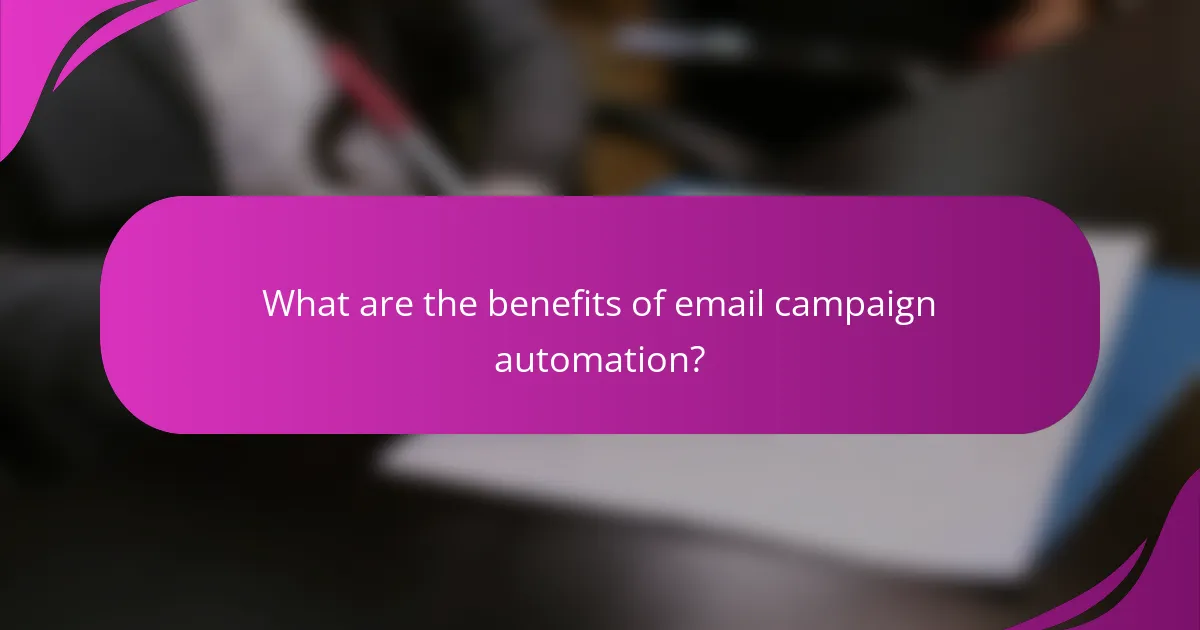
What are the benefits of email campaign automation?
Email campaign automation offers several advantages, including time savings, enhanced targeting, and improved engagement. By automating repetitive tasks, businesses can focus on strategy and creativity while delivering personalized content to their audience.
Increased efficiency
Automation streamlines the email marketing process by handling tasks such as scheduling, sending, and tracking campaigns. This allows marketers to save time and reduce the risk of human error, enabling them to focus on more strategic activities.
For instance, using automation tools, businesses can set up welcome emails, follow-ups, and reminders that trigger based on user actions, ensuring timely communication without manual intervention.
Improved targeting
Email campaign automation enhances targeting by allowing marketers to segment their audience based on behavior, preferences, and demographics. This means that messages can be tailored to specific groups, increasing relevance and effectiveness.
For example, a retailer could send personalized product recommendations to customers based on their past purchases, leading to higher conversion rates and customer satisfaction.
Higher engagement rates
Automated emails tend to achieve higher engagement rates due to their personalized nature and timely delivery. When recipients receive relevant content that aligns with their interests, they are more likely to open, click, and interact with the emails.
Studies suggest that targeted emails can lead to engagement rates that are significantly higher than generic messages, making it essential for businesses to leverage automation for maximum impact.
Cost-effectiveness
Email campaign automation can be a cost-effective solution for businesses of all sizes. By reducing the need for manual labor and minimizing errors, companies can lower operational costs while maintaining or increasing their marketing output.
Moreover, many automation tools offer scalable pricing models, allowing businesses to choose a plan that fits their budget and needs, making it accessible even for small enterprises.

How to choose the right email automation tool?
Choosing the right email automation tool involves assessing your specific business needs, budget, and integration capabilities. A well-suited tool will streamline your email marketing efforts and enhance customer engagement.
Assess your business needs
Start by identifying the primary goals of your email campaigns. Whether you aim to increase sales, nurture leads, or improve customer retention, your tool should align with these objectives. Consider the size of your audience and the complexity of your campaigns as well.
For example, small businesses may benefit from simpler tools with essential features, while larger organizations might require advanced functionalities like segmentation and A/B testing. Prioritize features that directly support your marketing strategy.
Evaluate pricing plans
Pricing plans for email automation tools can vary significantly, often ranging from free tiers to premium subscriptions. Assess what features are included at each price point and determine which plan fits your budget while meeting your needs.
Look for tools that offer a trial period or a money-back guarantee, allowing you to test their features before committing. Be cautious of hidden fees, such as charges for additional subscribers or advanced features.
Check integration capabilities
Ensure that the email automation tool can seamlessly integrate with your existing software, such as CRM systems, e-commerce platforms, and analytics tools. This capability is crucial for streamlining your workflows and maintaining data consistency.
Common integrations to look for include platforms like Shopify, Salesforce, or WordPress. A tool that easily connects with your current systems will save time and reduce manual data entry.
Read user reviews
User reviews provide valuable insights into the practical performance of email automation tools. Look for feedback on usability, customer support, and the effectiveness of features. Websites like G2 or Capterra can be helpful resources for gathering this information.
Pay attention to recurring themes in reviews, both positive and negative. This can help you gauge the reliability of the tool and whether it aligns with your expectations and requirements.
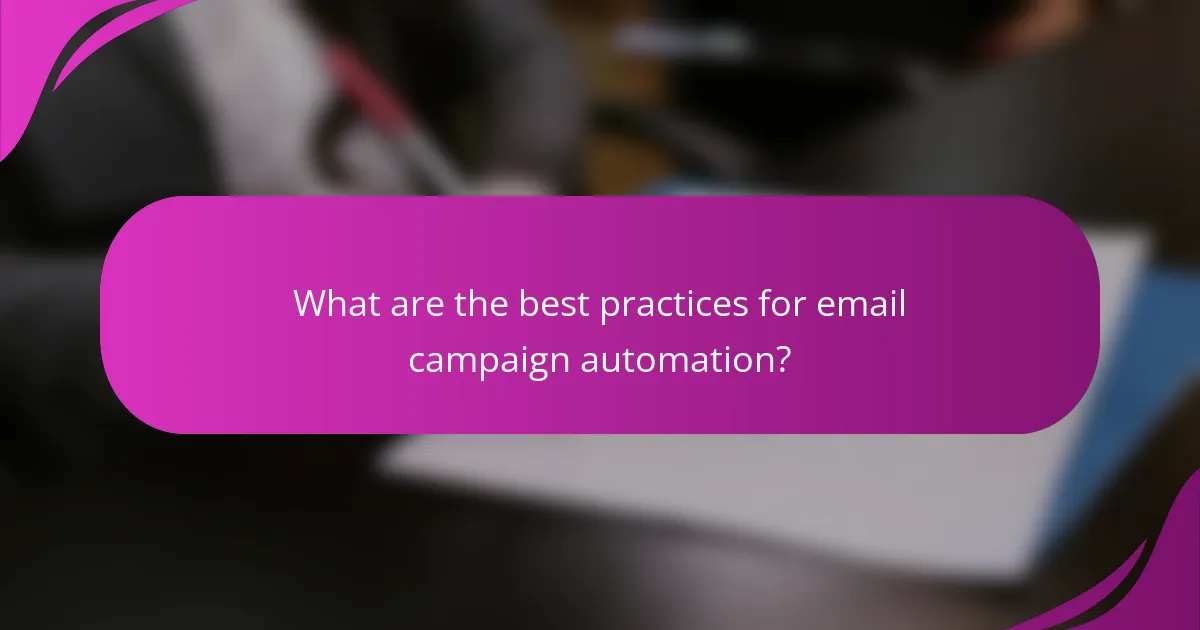
What are the best practices for email campaign automation?
Effective email campaign automation relies on several best practices that enhance engagement and conversion rates. Key strategies include audience segmentation, content personalization, continuous testing, and performance monitoring.
Segment your audience
Segmenting your audience involves dividing your email list into smaller groups based on shared characteristics such as demographics, behavior, or purchase history. This allows for more targeted messaging that resonates with each group, increasing the likelihood of engagement.
Consider using criteria like age, location, or past interactions to create segments. For example, a retail brand might segment customers into categories like “frequent buyers” and “occasional shoppers” to tailor promotions effectively.
Personalize content
Personalizing content means tailoring your emails to meet the specific needs and preferences of your audience segments. This can include using the recipient’s name, recommending products based on past purchases, or sending location-specific offers.
Personalization can significantly boost open and click-through rates. For instance, emails that include the recipient’s name in the subject line have been shown to increase engagement by a notable margin. Aim for a balance between automation and personal touch to maintain authenticity.
Test and optimize
Testing and optimizing your email campaigns involves experimenting with different elements, such as subject lines, send times, and content formats, to determine what works best. A/B testing is a common method where two variations of an email are sent to different audience segments to compare performance.
Regularly analyze results and adjust your strategies accordingly. For example, if one subject line outperforms another by a significant percentage, consider using similar styles in future campaigns. Continuous improvement is key to maximizing effectiveness.
Monitor performance metrics
Monitoring performance metrics is crucial for understanding the success of your email campaigns. Key metrics include open rates, click-through rates, conversion rates, and unsubscribe rates. These indicators provide insights into how well your emails are resonating with your audience.
Use analytics tools to track these metrics over time and identify trends. For instance, a consistent drop in open rates may signal the need for a content refresh or a change in sending frequency. Regular performance reviews help refine your approach and improve overall campaign effectiveness.
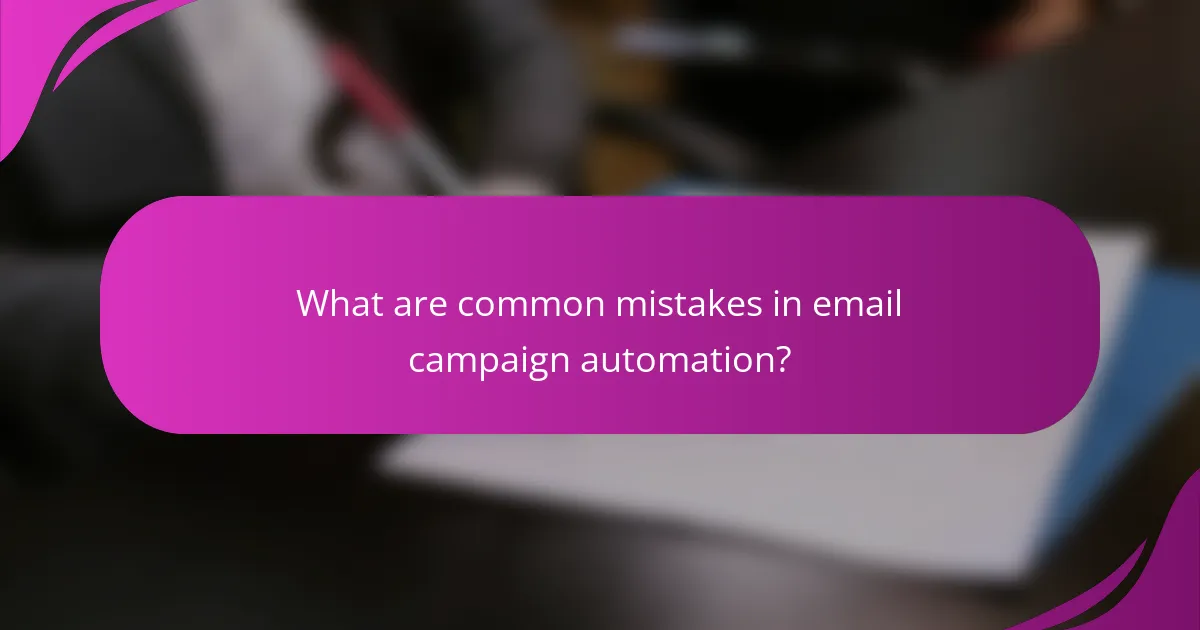
What are common mistakes in email campaign automation?
Common mistakes in email campaign automation include poor segmentation, lack of personalization, and neglecting to analyze results. These errors can lead to low engagement rates and wasted resources, ultimately undermining the effectiveness of the campaign.
Poor Segmentation
Poor segmentation occurs when email lists are not divided based on relevant criteria, such as demographics or past behavior. This often results in sending the same message to all recipients, which can alienate potential customers. Instead, segment your audience to tailor content that resonates with specific groups.
To improve segmentation, consider factors like purchase history, engagement levels, and geographic location. For example, a clothing retailer might segment customers by season preferences, sending winter promotions to those who previously purchased winter apparel.
Lack of Personalization
Lack of personalization in emails can make messages feel generic and uninviting. When emails do not address recipients by name or fail to reflect their interests, engagement rates typically decline. Personalization can be as simple as including the recipient’s name in the subject line or offering product recommendations based on previous purchases.
Utilizing dynamic content can enhance personalization efforts. For instance, an email might display different product images or offers based on the recipient’s browsing history, increasing the likelihood of conversion.
Neglecting to Analyze Results
Neglecting to analyze results is a critical mistake that can hinder future campaign success. Without reviewing key metrics such as open rates, click-through rates, and conversions, marketers miss valuable insights that can inform strategy adjustments. Regularly analyzing these metrics allows for continuous improvement in email campaigns.
Establish a routine for reviewing campaign performance, ideally after each major send. Use A/B testing to compare different subject lines or content formats, and apply findings to optimize future emails.
